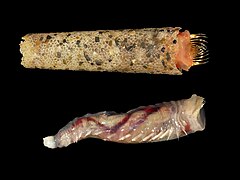Pectinariidae
| Pectinariidae Temporal range:
| |
|---|---|

| |
| Lagis koreni inside and out of its tube. Head is to the right. | |
| Scientific classification | |
| Kingdom: | |
| Phylum: | |
| Class: | |
| Subclass: | |
| Order: | |
| Family: | Pectinariidae Quatrefages, 1866
|
| Genera | |
|
2-5, see text. | |
Pectinariidae, or the trumpet worms or ice cream cone worms, are a family of marine polychaete worms that build tubes using grains of sand roughly resembling ice cream cones or trumpets. These structures can be up to 5 centimetres (2 in) long. The earliest pectinariid fossils are known from the Cretaceous.[1]
Ecology
Pectinariids are sessile burrowing tube dwellers, which can be found in fine-grained sediment. They position the wider end of their tube downwards, and use their stout golden setae for digging while they use tentacles for sorting the particles which they ingest. Half of the particles which the worm digs through are excreted as pseudofaeces.[2]
Genera
The systematics of the pectinariids have been the subject of some debate. Previously, only two genera have been recognized,[3] but three subgenera have been elevated to full genera by some scholars.[4][5]
- Amphictene Savigny, 1818 - sometimes included as subgenera in Pectinaria
- Cistenides Malmgren, 1866 - sometimes included as subgenera in Pectinaria
- Lagis Malmgren, 1866 - sometimes included as subgenera in Pectinaria
- Pectinaria Savigny, 1818
- Petta Malmgren, 1866
External links
- "Pectinariidae". Integrated Taxonomic Information System.
- from A Guide to Singapore Polychaetes
- Pectinaria at MBL Marine Organisms Database
- Family Pectinariidae
- The Polychaeta Terebellida homepage: Pectinariidae
References
- ^ Vinn, O.; Luque,J. (2013). "First record of a pectinariid-like (Polychaeta, Annelida) agglutinated worm tube from the Late Cretaceous of Colombia". Cretaceous Research. 41: 107–110. doi:10.1016/j.cretres.2012.11.004. Retrieved 2014-06-11.
- ^ Fauchald, K., & Jumars, P. A. (1979). The diet of worms: a study of polychaete feeding guilds.
- ^ Ushakov, P. V., & Pavlovskiĭ, E. N. (1965). Polychaeta of the Far Eastern Seas of the USSR Chief Editor: EN Pavlovskiĭ. Israel Program for Scientific Translations.
- ^ Fauchald, K. (1977). The polychaete worms, definitions and keys to the orders, families and genera. Natural History Museum of Los Angeles County, Science Series, 28.
- ^ Hutchings, P., & Peart, R. (2002). A review of the genera of Pectinariidae (Polychaeta) together with a description of the Australian fauna. RECORDS-AUSTRALIAN MUSEUM, 54(1), 99-127.
